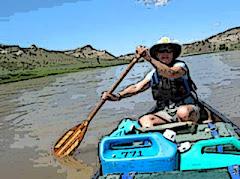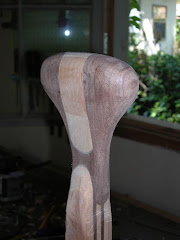Todd Bradshaw (on the WCHA forum) said that I should varnish the epoxy if for no other reason than that the epoxy is not UV-resistant. He suggested I sand it while green and then varnish it. Sounds like a good idea to me. If I get the power face glassed this weekend, I can have the whole paddle sanded and ready for a finish by next weekend. I can put on one coat of varnish/week for three weeks, apply four-five coats of the linseed oil/varnish/turp finish to the shaft and grip in between coating the blade, and have at least a month of cure-time before the trip.
I sanded the front face and cleaned everything up as much as possible with the shop vac. I did it before epoxying the power face because I wanted to make sure the edges were smooth and that I wasn't going to add another layer of epoxy over a rough edge--making it that much harder to clean up later.
Then I put the first layer of epoxy/fiberglass down on the power face. This time, I paid very close attention to smoothing out air bubbles, and the overall layer of epoxy wound up being much thinner. It was still easy enough to smooth out, though, and hopefully any high spots will level. Before I did th second side, I was wondering why I had to do two coats of epoxy. Couldn't I just do one thick coat and let it level out?
Well, the answer is (dope slap), no. You do a first thin coat because that allows you to get rid of the air bubbles. If you leave it thick, you can't squeegee them out.

 These photos were sent to me by Erin from the first day she worked on he paddle. She reports that it's coming along nicely, and we're currently making plans to have a show and tell (with Kurt's paddle there, too, hopefully)
These photos were sent to me by Erin from the first day she worked on he paddle. She reports that it's coming along nicely, and we're currently making plans to have a show and tell (with Kurt's paddle there, too, hopefully)


